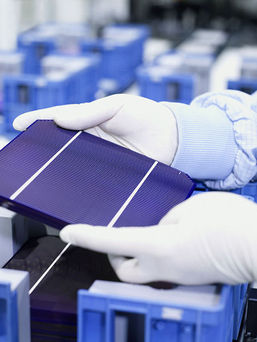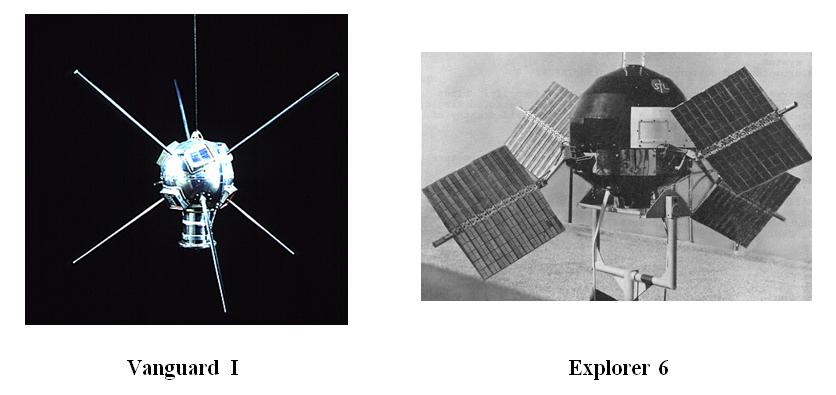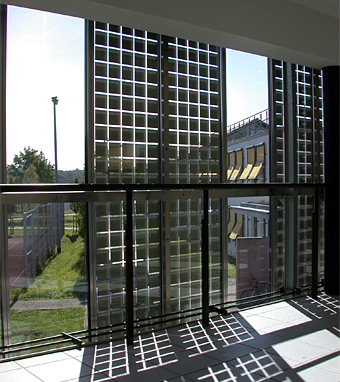By Home
What is a solar cell and how does it work?

A solar cell, also known as a photovoltaic cell, is an electrical device that converts the frequency of light into the frequency of electricity. The word “Photo” in Greek means light and “Volt” is the unit of electricity. The amount of current & voltage vary depending upon the type and intensity of light falling upon it. If the ambient light is low, when it is a cloudy day a lens can be used to converge the rays of light and increase the intensity of light on the chip. This is one way to increase the current and voltage from a single solar cell. Another way would be to use reflecting surfaces like glass or mirrors to redirect more rays of light on to the target cell surface.
A solar panel is a set of solar photovoltaic modules electrically connected and mounted on a supporting structure. A photovoltaic module is a packaged, connected assembly of solar cells. The solar panel can be used as a component of a larger photovoltaic system to generate and supply electricity in commercial and residential applications. Each module is rated by its DC output power under standard test conditions (STC), and typically ranges from 100 to 320 watts. The efficiency of a module determines the area of a module given the same rated output - an 8% efficient 230 watt module will have twice the area of a 16% efficient 230 watt module
A solar panel is a set of solar photovoltaic modules electrically connected and mounted on a supporting structure. A photovoltaic module is a packaged, connected assembly of solar cells. The solar panel can be used as a component of a larger photovoltaic system to generate and supply electricity in commercial and residential applications. Each module is rated by its DC output power under standard test conditions (STC), and typically ranges from 100 to 320 watts. The efficiency of a module determines the area of a module given the same rated output - an 8% efficient 230 watt module will have twice the area of a 16% efficient 230 watt module
History of Solar Cells
Satellite Vanguard I, launched in 1958 was the first space satellite to use Solar Cells. The plan for the satellite was to operate from its battery for a short time and stop when the battery ran down. By adding cells to the outside of the body, the mission time could be extended with no major changes to the spacecraft or its power systems. In 1959 the United States launched Explorer 6. It featured large solar arrays resembling wings, which became a major hit and the wings became a common feature in future satellites.
In the initial days the cells were developed for toys and other minor uses, as the cost of the electricity they produced was very high; in relative terms, a cell that produced 1 watt of electrical power in bright sunlight cost about $250, comparing to $2 to $3 per watt for a coal plant.
In 1960 itself, the Exxon group had already concluded that electrical power would be much more expensive by 2000, and felt that this increase in price would make new alternative energy sources more attractive, and solar was the most interesting among these. They also concluded that if the price per watt were reduced from then-current $100/watt to about $20/watt there would be significant demand.
In 1960 itself, the Exxon group had already concluded that electrical power would be much more expensive by 2000, and felt that this increase in price would make new alternative energy sources more attractive, and solar was the most interesting among these. They also concluded that if the price per watt were reduced from then-current $100/watt to about $20/watt there would be significant demand.

When the New Jersey Exxon lab, Solar Power Corporation (SPC) started making navigational buoys as a natural market for their products but they found that the primary company in the business was Automatic Power, a battery manufacturer. Realizing that solar cells might eat into their battery profits, Automatic had purchased a solar navigation aid prototype from Hoffman Electronics and shelved it. There are multiple examples of car companies making Electric cars finding that they are outperforming their Petrol counterparts and shelving them. Toyota Rav EV and Honda Jazz EV (also known as Honda Fit EV) are some of the major EV producers who made good Electrical cars but never sold a single one citing lame excuses.
In recent times, further improvements have brought the Solar Cell production costs down under $1 a watt, with wholesale costs well under $2. In fact the cost of wiring, switches, support racks, an inverter, and batteries which are known as “Balance of system" costs are now more than the panels themselves. Large commercial arrays can be built and fully commissioned at below $3.40 a watt (2010 prices).
In recent times, further improvements have brought the Solar Cell production costs down under $1 a watt, with wholesale costs well under $2. In fact the cost of wiring, switches, support racks, an inverter, and batteries which are known as “Balance of system" costs are now more than the panels themselves. Large commercial arrays can be built and fully commissioned at below $3.40 a watt (2010 prices).
China has succeeded in bringing down the prices of the crystalline solar-based modules further, to about $1.09 per watt in October 2011, down sharply from the price per watt in 2010. Prices continued to fall in 2012, reaching $0.62/watt by the 4th Quarter of 2012 and prices reduced further in 2013.
China has played by far the most important role in changing the face of solar cell manufacturing in recent years. China today is… the largest manufacturer and exporter of solar panels in the world… and it will remain so for the next 2 decades to come.
China has played by far the most important role in changing the face of solar cell manufacturing in recent years. China today is… the largest manufacturer and exporter of solar panels in the world… and it will remain so for the next 2 decades to come.
There are various types of Solar Cells like:
Crystalline silicon
By far, the most prevalent bulk material for solar cells is crystalline silicon known as c-Si, also known as "solar grade silicon". Bulk silicon is separated into multiple categories according to crystallinity and crystal size in the resulting ingot, ribbon, or wafer. Some of them are:
Crystalline silicon
By far, the most prevalent bulk material for solar cells is crystalline silicon known as c-Si, also known as "solar grade silicon". Bulk silicon is separated into multiple categories according to crystallinity and crystal size in the resulting ingot, ribbon, or wafer. Some of them are:

Monocrystalline silicon (c-Si):
Single-crystal wafer cells tend to be expensive, and because they are cut from cylindrical ingots, do not completely cover a square solar cell module without a substantial waste of refined silicon. Hence most c-Si panels have uncovered gaps at the four corners of the cells.
Single-crystal wafer cells tend to be expensive, and because they are cut from cylindrical ingots, do not completely cover a square solar cell module without a substantial waste of refined silicon. Hence most c-Si panels have uncovered gaps at the four corners of the cells.

Polycrystalline silicon, or Multi-Crystalline silicon, (poly-Si or mc-Si):
Made from cast square ingots — large blocks of molten silicon carefully cooled and solidified. Poly-Si cells are less expensive to produce than single crystal silicon cells, but are less efficient and due to their lower price there was a higher number of polycrystalline sales than Mono-Crystalline silicon sales.
Made from cast square ingots — large blocks of molten silicon carefully cooled and solidified. Poly-Si cells are less expensive to produce than single crystal silicon cells, but are less efficient and due to their lower price there was a higher number of polycrystalline sales than Mono-Crystalline silicon sales.
Ribbon Silicon:
Ribbon Silicon is a type of polycrystalline silicon. It is formed by drawing flat thin films from molten silicon and results in a polycrystalline structure. These cells have lower efficiencies than poly-Si, but save on production costs due to a great reduction in silicon waste, as this approach does not require sawing from ingots.
Ribbon Silicon is a type of polycrystalline silicon. It is formed by drawing flat thin films from molten silicon and results in a polycrystalline structure. These cells have lower efficiencies than poly-Si, but save on production costs due to a great reduction in silicon waste, as this approach does not require sawing from ingots.
Mono-like-multi silicon:
Developed in the 2000s and introduced commercially around 2009, mono-like-multi, or cast-mono, uses existing polycrystalline casting chambers with small "seeds" of mono material. The result is a bulk mono-like material with poly around the outsides. When sawn apart for processing, the inner sections are high-efficiency mono-like cells (but square instead of "clipped"), while the outer edges are sold off as conventional poly. The result is line that produces mono-like cells at poly-like prices
Developed in the 2000s and introduced commercially around 2009, mono-like-multi, or cast-mono, uses existing polycrystalline casting chambers with small "seeds" of mono material. The result is a bulk mono-like material with poly around the outsides. When sawn apart for processing, the inner sections are high-efficiency mono-like cells (but square instead of "clipped"), while the outer edges are sold off as conventional poly. The result is line that produces mono-like cells at poly-like prices
Thin films:
Thin-film technologies reduce the amount of material required in creating the active material of solar cell. Since silicon solar panels only use one pane of glass, thin film panels are approximately twice as heavy as crystalline silicon panels, although they have a smaller ecological impact. The majority of film panels have significantly lower conversion efficiencies, lagging silicon by two to three percentage points.
There are also manufacturers that are using thin film to use flexible solar panels. The advantages of the light thin film flexible solar panels are that they save on the aluminum/steel/iron structural frames the cost of which is more than the cost of the panels themselves. The flexible panels can be stuck on or held down by a fraction of the frame required to hold traditional panels. These flexible panels could also double up as a main sail for a boat generating electricity at the same time using wind to cruise the boat ahead.
Thin-film technologies reduce the amount of material required in creating the active material of solar cell. Since silicon solar panels only use one pane of glass, thin film panels are approximately twice as heavy as crystalline silicon panels, although they have a smaller ecological impact. The majority of film panels have significantly lower conversion efficiencies, lagging silicon by two to three percentage points.
There are also manufacturers that are using thin film to use flexible solar panels. The advantages of the light thin film flexible solar panels are that they save on the aluminum/steel/iron structural frames the cost of which is more than the cost of the panels themselves. The flexible panels can be stuck on or held down by a fraction of the frame required to hold traditional panels. These flexible panels could also double up as a main sail for a boat generating electricity at the same time using wind to cruise the boat ahead.
Multi-Junction cells
Multi-junction solar cells are solar cells which can produce electricity through different wavelength of the same beam of light. A multi-junction cell solar cell will produce electric current at multiple wavelengths of light, increasing the conversion efficiency of the no-cost solar light power to usable electric power.
Traditional single-junction cells have a maximum theoretical efficiency of 34%. Theoretically, with an infinite number of junctions, multi-junction cell efficiency would be 87% under highly concentrated sunlight.
However, this efficiency is gained at the cost of increased complexity and manufacturing price. To date, their higher price and higher price-to-performance ratio have limited their use to special roles, notably in aerospace where their high power-to-weight ratio is desirable. In terrestrial applications these solar cells have been suggested for use in concentrated photovoltaics (CPV)
Multi-junction solar cells are solar cells which can produce electricity through different wavelength of the same beam of light. A multi-junction cell solar cell will produce electric current at multiple wavelengths of light, increasing the conversion efficiency of the no-cost solar light power to usable electric power.
Traditional single-junction cells have a maximum theoretical efficiency of 34%. Theoretically, with an infinite number of junctions, multi-junction cell efficiency would be 87% under highly concentrated sunlight.
However, this efficiency is gained at the cost of increased complexity and manufacturing price. To date, their higher price and higher price-to-performance ratio have limited their use to special roles, notably in aerospace where their high power-to-weight ratio is desirable. In terrestrial applications these solar cells have been suggested for use in concentrated photovoltaics (CPV)
Since these multi-junction cells require several different materials on top of each other with very specific tunnel junction layers between them, the solar cell itself is very expensive. The way to make this technology cost effective is to make a very small solar cell that captures sunlight from a very large area with concentrating mirrors.
A drawback of concentrators is that the angle of incidence for sunlight has to be close to normal so these systems need to have trackers that follow the path of the sun throughout the day. These trackers are expensive and add to the fixed cost of the cell as well as add an unfortunate maintenance cost to these systems due to the moving parts in the motors that turn the system. Another drawback of this system is that they do not work well at all on cloudy days.
A drawback of concentrators is that the angle of incidence for sunlight has to be close to normal so these systems need to have trackers that follow the path of the sun throughout the day. These trackers are expensive and add to the fixed cost of the cell as well as add an unfortunate maintenance cost to these systems due to the moving parts in the motors that turn the system. Another drawback of this system is that they do not work well at all on cloudy days.
Transparent Solar Cells:
In 2011, researchers at the Massachusetts Institute of Technology and Michigan State University developed the first highly efficient transparent solar cells that had power efficiency close to 2% with a transparency to the human eye greater than 65%.
Researchers at UCLA more recently developed an analogous polymer solar cell, following the same approach that is 70% transparent and has 4% power conversion efficiency.
These lightweight, flexible cells can be produced in bulk at a low cost, and could be used to create power generating windows, especially for cars – all cars electric and non-electric.
In 2011, researchers at the Massachusetts Institute of Technology and Michigan State University developed the first highly efficient transparent solar cells that had power efficiency close to 2% with a transparency to the human eye greater than 65%.
Researchers at UCLA more recently developed an analogous polymer solar cell, following the same approach that is 70% transparent and has 4% power conversion efficiency.
These lightweight, flexible cells can be produced in bulk at a low cost, and could be used to create power generating windows, especially for cars – all cars electric and non-electric.
Transparent Solar Cells is the most exciting find of them all due to their multiple uses and the fact that it can be easily incorporated into our daily building life style. These can be used as transparent glass on the exterior of most modern office or resident skyscraper towers. They can be used on car windshield and windows. The roof of the car can have a huge sunroof made of transparent solar cell.
Solar Energy can do away with large transmission wires and towers. These towers can be converted to Wind turbine towers overnight. Since in Solar cells the electricity generated is in DC and since we do not need to step up or step down the power for transmission, converting to AC is not needed. These can be independent sustainable power units serving a group of houses. For detailed explanation see the below video:





